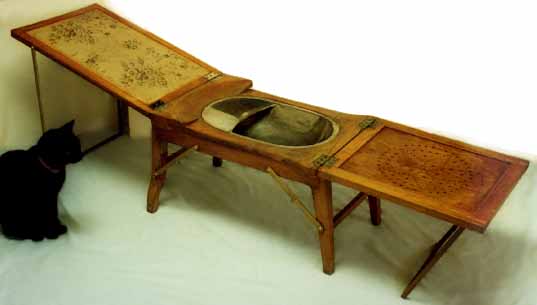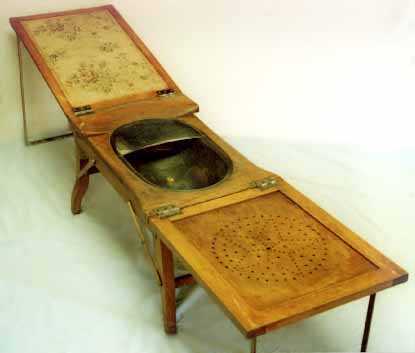See a set of the Daintette vaginal douche,
with pamphlets, etc., 1928-29?, U.S.A.
"Faultless
Feminine
Syringe," No. 240, made by the
Faultless Rubber Company, Ashland, Ohio,
U.S.A., perhaps from the 1960s or 1970s.


|

Portable bidet, in the ready-to-use
position (Paris, France, 1928)
A bidet has allowed men and
women since possibly the Crusades
(11th to the 13th centuries) to
wash feet, hair, beards, genitals
and perineum. The bather usually rides it
like a pony; pony is what the
word meant in the French
of 400 or so years ago. Bidets
today often fit onto toilets.
The
beautiful bidet featured here,
below, seems to be made
of oak, heavy enough to withstand
water and usage, and metal painted
a gold color. There are no fancy
jets of water; the user poured
water over her genitals - the
old-fashioned way.
|
|

|
The black object at
left, the cat Prof. Mack
C. Padd, the Distinguished
Service Institutional Wallace C.
Meyer Memorial Pouncer at the
Museum of Menstruation, memorizes the
grain pattern in the bidet's
wood to present to detectives in
case the bidet is stolen. No,
wait a second, I think he's
actually asleep.
Underneath the right section there
is a metal
plate bearing the
following words:
Siege -
MATHIEU
B[?] S.G.D.G
DIPLôME D'HONNEUR
10, Rue Lacuée PARIS
(All photos by
MUM director Harry Finley)
|
|

|
The closest section
of the bidet sports a
star-and-circle design formed by
holes through the wood, probably
allowing heat and drips from a pot
of water to escape from the
surface, rather than puddle there.
I believe the bidet-er, sitting on
the far end of the center section,
put a pot on this near section,
from which she poured water onto
her genitals, the water then
flowing into the central basin,
which had a drain stopped by a
cork (the light-colored patch
above the near rim). See a drawing
showing this.
|
© 1999 Harry Finley. It is illegal to
reproduce or
distribute work on this Web site in any
manner or
medium without written permission of the
author.
Please report suspected violations to hfinley@mum.org
|